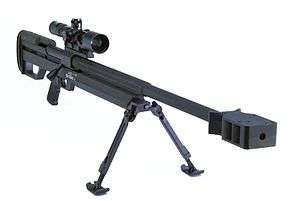Anti-materiel rifle



An anti-materiel rifle (AMR) is a rifle that is designed for use against military equipment (materiel), rather than against other combatants ("anti-personnel").
History
The origins of the anti-materiel rifle go back to the First World War, during which the first anti-tank rifles appeared. While modern tanks and most other armored vehicles are too well protected to be affected by anti-materiel rifles, the guns are still effective for attacking unarmored or lightly armored vehicles. They can also be used against stationary enemy aircraft, missile launchers, radar equipment, small watercraft, communications equipment, crew served weapons and similar targets. Their value is in being able to precisely target and disable enemy assets from long range for a relatively low cost.
Despite having been designed to be used against equipment, the rifles also proved useful in dispatching enemy personnel from superior range, including enemy snipers. This, however, requires that the enemy cannot use arms with similar effective range – which e.g. was the case during the War on Terror in Afghanistan.
The offensive use of anti-materiel rifles or special application scoped rifles (SASR) is termed hard target interdiction (HTI) by the United States military.[1]
Anti-materiel rifles can also be used in non-offensive roles, e.g.; for safely destroying unexploded ordnance.
Description
Anti-materiel rifles are similar in form and appearance to modern sniper rifles and can often serve in that role, though they are usually chambered for cartridges more powerful than are normally required for killing a human and can operate at a greater range.
In general, anti-materiel rifles are chambered for 12.7×99mm NATO (.50 BMG), 12.7×108mm Russian, 14.5×114mm Russian, and 20mm cartridges. The large cartridges are required to be able to fire projectiles containing usable payloads, such as explosives, armor-piercing cores, incendiaries, or combinations of these, as found in the Raufoss Mk 211 projectile.
The recoil produced by the employed cartridges dictates that these rifles are designed to be fired from the prone position. Bipods and monopods and muzzle brakes are used as accessories to employ these rifles as comfortably and accurately as possible. Firing several 12.7×99mm NATO, 12.7×108mm Russian, or larger caliber shots from the (unsupported) standing position or in a kneeling position would be very uncomfortable for the operator and can result in them being knocked over or sustaining a shoulder injury.
Due to the considerable size and weight of anti-materiel rifles and other support equipment, sniper cells operating in 2- or 3-man or larger teams have become a necessity.
List of anti-materiel rifles
The following table contains a sortable list of some anti-materiel rifles.
| Rifle | Country of origin | Caliber |
|---|---|---|
| Steyr HS .50 | Austria | .50 BMG (12.7×99mm NATO) |
| Steyr IWS 2000 | Austria | 15.2mm proprietary SteyAr APFSDS |
| Istiglal | Azerbaijan | 14.5×114mm |
| AMR-2 | China | 12.7×108mm (.50 Russian) |
| JQ | China | 12.7×108mm (.50 Russian) |
| JS 12.7 | China | 12.7×108mm (.50 Russian) |
| LR2A | China | 12.7×108mm (.50 Russian) |
| M99B / M06 | China | 12.7×108mm (.50 Russian) .50 BMG (12.7×99mm NATO) |
| W03 | China | 12.7×108mm (.50 Russian) |
| RT-20 | Croatia | 20×110mm Hispano |
| Mambi AMR | Cuba | 14.5×114mm |
| CZW-127 | Czechia | .50 BMG (12.7×99mm NATO) 12.7×108mm (.50 Russian) |
| Falcon | Czechia | .50 BMG (12.7×99mm NATO) 12.7×108mm (.50 Russian) |
| PGM Hecate II | France | .50 BMG (12.7×99mm NATO) |
| PDSHP | Georgia | 14.5×114mm |
| DSR-Precision GmbH DSR-50 | Germany | .50 BMG (12.7×99mm NATO) |
| Gepárd anti-materiel rifles | Hungary | .50 BMG (12.7×99mm NATO), 12.7×108mm (.50 Russian), 14.5×114mm Russian |
| Vidhwansak | India | 12.7×108mm (.50 Russian) 14.5×114mm 20×82mm |
| Pindad SPR-2 and SPR-3 | Indonesia | .50 BMG (12.7×99mm NATO) on SPR-2, 7.62 NATO on SPR-3 |
| Shaher | Iran | 14.5×114mm (.57 Russian) |
| Tor | Poland | .50 BMG (12.7×99mm NATO) |
| KSVK | Russia | 12.7×108mm (.50 Russian) |
| OSV-96 | Russia | 12.7×108mm (.50 Russian) |
| Zastava M93 Black Arrow | Serbia | .50 BMG (12.7×99mm NATO) or 12.7×108mm (.50 Russian) |
| Denel NTW-20 | South Africa | 14.5×114mm Russian (NTW 14.5) 20×83.5mm (NTW 20) 20×110mm (NTW 20) |
| Truvelo SR-20[2] | South Africa | 14.5×114mm 20×82mm 20×110mm |
| SAN 511 (formerly OM 50 Nemesis) | Switzerland | .50 BMG (12.7×99mm NATO) |
| Accuracy International AS50 | United Kingdom | .50 BMG (12.7×99mm NATO) |
| Accuracy International AW50 | United Kingdom | .50 BMG (12.7×99mm NATO) |
| Accuracy International AW50F | United Kingdom | .50 BMG (12.7×99mm NATO) |
| Accuracy International AX50 | United Kingdom | .50 BMG (12.7×99mm NATO) |
| Barrett M82A1/M107 | United States | .50 BMG (12.7×99mm NATO) |
| Barrett M90 | United States | .50 BMG (12.7×99mm NATO) |
| Barrett M95 | United States | .50 BMG (12.7×99mm NATO) |
| Barrett M99 | United States | .50 BMG (12.7×99mm NATO) .416 Barrett |
| Barrett XM500 | United States | .50 BMG (12.7×99mm NATO) |
| Barrett XM109 | United States | 25×59mm |
| Iver Johnson AMAC-1500 | United States | .50 BMG (12.7×99mm NATO) |
| McMillan Tac-50 | United States | .50 BMG (12.7×99mm NATO) |
| Desert Tech HTI | United States | .50 BMG (12.7×99mm NATO) |
See also
- Anti-tank rifle
- High-explosive incendiary/armor-piercing ammunition
- List of firearms
- Raufoss Mk211
- Sniper rifle
- Designated marksman rifle
References
- ↑ Hard Target Interdiction, By Michael Haugen - snapshot from the Wayback Machine, dated July 19, 2007
- ↑ "Sniper Rifles". Archived from the original on 2010-04-03.
External links
| Wikimedia Commons has media related to Anti-materiel rifles. |